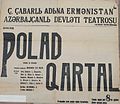Social:I with bowl
Template:Infobox grapheme I with bowl (majuscule: Ь, minuscule: ь)[note 1] is an additional letter of the Latin alphabet. It was introduced in 1928 into the reformed Yañalif, and later into other alphabets for Soviet minority languages. The letter was designed specifically to represent the non-front close vowel sounds Template:IPA2 and Template:IPA2.[1] Thus, this letter corresponds to the letter ⟨I ı⟩ in modern Turkic alphabets.[2][3][4][5][6][7]
Usage
The letter was originally included in the Yañalif, and later also in the alphabets of the Kurdish, Abaza, Sami, Ingrian, Kalmyk, Komi, Tsakhur, Azerbaijani and Bashkir languages, as well as in the draft reform of the Udmurt alphabet. During the project of the Latinization of the Russian language, this letter corresponded to the Cyrillic letter ⟨Ы ы⟩. In Kalmyk, however, it represented palatalisation of the preceding consonant, thus corresponding to the Cyrillic homoglyph ⟨Ь ь⟩.
In languages and alphabets that used this letter, the lowercase form of B was a small capital ⟨ʙ⟩ so that there would be no confusion between ⟨b⟩ and ⟨ь⟩.
New Turkic alphabet (Yañalif)
The Latin-based Unified Northern Alphabet
Encoding
A Latin letter I with bowl hasn't been adopted into Unicode because of the concern that encoding it could open the door to "duplicating the whole Cyrillic alphabet as Latin letters."[8][9][10][11] Instead, computer and mobile users can substitute similar letters, either Ь ь or Ƅ ƅ (Latin letter tone six, the letter that was previously used in the Zhuang alphabet to denote the sixth tone Template:IPA2).
See also
Notes
- ↑ Here represented with the Cyrillic soft sign, to which it is homoglyphic
References
- ↑ W. K. Matthews (2013). Languages of the USSR. Cambridge: Cambridge University Press. pp. 71. ISBN 978-1-107-62355-2. https://books.google.com/books?id=RWNsAAAAQBAJ&pg=PA70.
- ↑ Tatar (tatarça / татарча / تاتارچا)
- ↑ Azerbaijani (آذربايجانجا ديلي / Azərbaycan dili / Азәрбајҹан дили)
- ↑ Karaim (къарай тили, Karay dili, לשון קדר)
- ↑ Khakas (Хакас тілі / Khakas tîlî)
- ↑ Kumyk (Къумукъ тил / Qumuq til)
- ↑ Tuvan (Тыва дыл / Tyva dyl)
- ↑ Karl Pentzlin, Ilya Yevlampiev (2008-11-03). "Proposal to encode four Latin letters for Jaꞑalif". http://www.unicode.org/L2/L2008/08404r-janalif.pdf.
- ↑ Karl Pentzlin, Ilya Yevlampiev (2010-09-24). "Proposal to encode two Latin letters for Jaꞑalif". http://www.unicode.org/L2/L2010/10356-n3916-janalif.pdf.
- ↑ "Proposal to encode Latin letters used in the Former Soviet Union". 2011-10-18. http://www.unicode.org/L2/L2011/11360-soviet-latin.pdf.
- ↑ Nikita Manulov (2022-05-20). "Proposal to encode Latin capital and small letter I with bowl". https://www.unicode.org/L2/L2022/22118-latin-i-with-bowl.pdf.
 |























